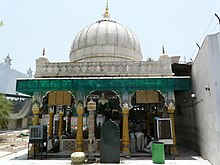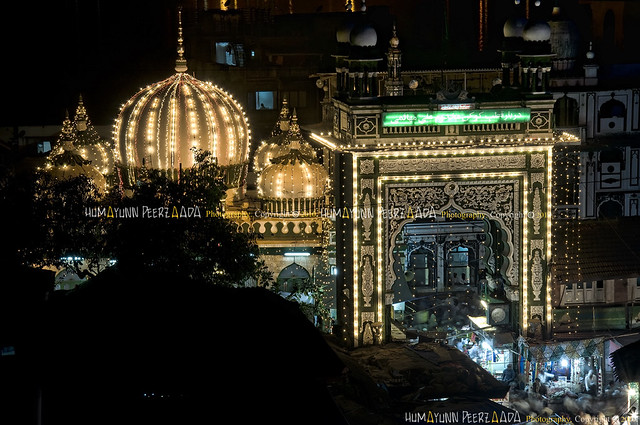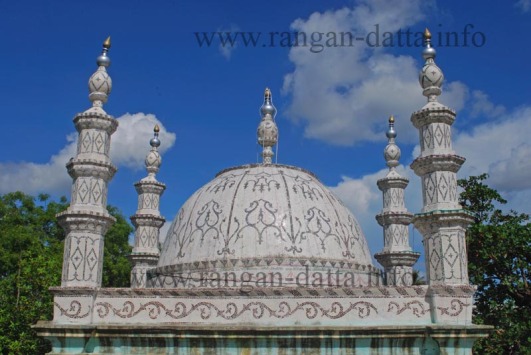 |
| Dargha Of Abdul Wahab Siddiqui(R.A) |
There are so many Miracles we found in to the life of Hazrat Abdul Wahab Siddiqui(R.A). If all of the Miracles has been narrated here then it's became an epic so why some of them are highlighted here.
Cured from illnesses:
AbdulWahabSiddiqui(R.A)was very much known for his curing power from different health related problem.
(i) Once when Abdul Wahab Siddiqui(R.A) was in South America, a man was in serious condition lying into coma for long time and the Doctors declared him 3 days for his life. When Abdul Wahab Siddiqui(R.A) met him to examined he state that within 3 days we saw him reading poem in deep respect of the "Prophet(s.a.w.s)". As he state we saw on the day third the man was walking towards the poem book to recite on his bed.
(ii) he another incident we noticed, when a man visit to Abdul Wahab Siddiqui(R.A) to requesting of his prayers for his sister, who was in coma due to heart attack. The Doctors declared that they can't do anything more for his sister and also suggested to switched off the "life support machine". Then Abdul Wahab Siddiqui(R.A) gave a taweez to place on the chest of his sister. After doing this his sister came out from the coma on the 12th day.
(iii) There was another story we noticed that a couple came one day from Coventry(England) to meet Abdul Wahab Siddiqui(R.A) for solve there problem. As the couple couldn't have there children and the Doctors declared, to them as she had a 'hole' in the heart, the lady was not capable for bearing child. Abdul Wahab Siddiqui(R.A) gave a taweez for the lady after hearing there problem. Few weeks later the same Doctor confirmed that, there was not any hole into the heart of the lady and now she can take the responsibility of bearing the child.
Foreknowledge by the great Saint Abdul Wahab Siddiqui(R.A):
(i) Once when Abdul Wahab Siddiqui(R.A) was addressing to the congregation he state that do not participate in a particular time of the ritual of stoning during Hajj. But Some present ulema do not agree with the suggestion, they thought it was the right time to perform the ritual according to the "sunnah of Prophet Mohammad(s.a.w.s). Hazrat Abdul Wahab Siddiqui(R.A) agree with the ulemas but pleaded to the congregation that do not participate in this traditional one in this period of time. After two days there was a huge fire broke out at the particular place of ritual at the same time that Hazrat Abdul Wahab Siddiqui(R.A) was suggested. The ulema came back to Hazrat Abdul Wahab Siddiqui(R.A) after receiving the news and affirmed, that Abdul Wahab SIddiqui(R.A) was actually a great 'Saint'.
(ii) Once Hazrat Abdul Wahab Siddiqui(R.A) was facing to a man, who wanted to know why Abdul Wahab Siddiqui(R.A) was 'considered' as a "friend of God". After persisted by the man, Abdul Wahab Siddiqui(R.A) told the man to go back home where you saw your mother cutting vegetables(preparation-for the "evening meal"). As the man came back to his home he saw exactly the same situation. After this he went to Hazrat Abdul Wahab Siddiqui(R.A) and embraced him. The man affirmed that Hazrat Abdul Wahab Siddiqui(R.A) was actually a great "Walli Allah".
Abdul Wahab Siddiqui(R.A) was present simultaneously in different function:
Once when Abdul Wahab Siddiqui(R.A) and some of his disciples were returning from the "Prophet(s.a.w.s)" Mosque(in Madinatul Munawwarah), a man came to him and invited Abdul Wahab Siddiqui(R.A) in a function in the occasion of the birth celebration of the "Prophet(s.a.w.s)"(mehfil-e-milad).
Abdul Wahab Siddiqui(R.A) was present simultaneously in different function:
Once when Abdul Wahab Siddiqui(R.A) and some of his disciples were returning from the "Prophet(s.a.w.s)" Mosque(in Madinatul Munawwarah), a man came to him and invited Abdul Wahab Siddiqui(R.A) in a function in the occasion of the birth celebration of the "Prophet(s.a.w.s)"(mehfil-e-milad).
The function was take place to the next day at his home. Abdul Wahab Siddiqui(R.A) accept the invitation and promise to the man, that he was present on the function and also delivered a 'sermon' on the occasion after his esha prayers on the same day.
To the next day Abdul Wahab Siddiqui(R.A) was invited by the host Sheikh Zia Uddin Qadri(R.A) [(he was a great "Muslim Scholar" and also a Khalifa of "Ala Hazrat"-Hazrat Ahmed Raza Khan Barelvi(R.A)] to another function of mehfil-e-milad. At the time of esha Abdul Wahab Siddiqui(R.A) instructed to his disciples to attend the function of milad. Due to respect towards thers Saint, the disciples didn't remind about the another invitation at the "same time".
In the house of "Sheikh Zia Uddin Qadri(R.A), Abdul Wahab Siddiqui(R.A) with his disciples attended the function, where the Ulemas was gathered in large numbers. On the 'love' of the "Holy Prophet(s.a.w.s)", Abdul Wahab Siddiqui(R.A) was delivered his sermon as he called at the last. By the time as the function had ended, his disciples were disappointed with the fact that there was quite late for Abdul Wahab Siddiqui(R.A) to attend the another function which was organised by the man who also invited him.
Next day at the time of zuhr(afternoon prayer time) when Abdul Wahab Siddiqui(R.A) with his disciples had left the Mosque of the Holy Prophet(s.a.w.s), they saw the 1st man( the man who had 'invited' Abdul Wahab Siddiqui(R.A) to his function of milad ) approaching with speed. The disciples expecting the man to be upset , but fortunately the man was very pleased and embraced Abdul Wahab Siddiqui(R.A) very emotionally. The man expressed his experience of the presence of Abdul Wahab Siddiqui(R.A) at his function and said that it was one of "the best speeches" by Abdul Wahab Siddiqui(R.A) as the attendance said who had heard him. After knowing all the fact the disciples realised that it was not only the truth but a Miracle of Abdul Wahab Siddiqui(R.A). Abdul Wahab Siddiqui(R.A) smiled at his disciples and instructed do not expose this incident to any one until he gave the permission.
To the next day Abdul Wahab Siddiqui(R.A) was invited by the host Sheikh Zia Uddin Qadri(R.A) [(he was a great "Muslim Scholar" and also a Khalifa of "Ala Hazrat"-Hazrat Ahmed Raza Khan Barelvi(R.A)] to another function of mehfil-e-milad. At the time of esha Abdul Wahab Siddiqui(R.A) instructed to his disciples to attend the function of milad. Due to respect towards thers Saint, the disciples didn't remind about the another invitation at the "same time".
In the house of "Sheikh Zia Uddin Qadri(R.A), Abdul Wahab Siddiqui(R.A) with his disciples attended the function, where the Ulemas was gathered in large numbers. On the 'love' of the "Holy Prophet(s.a.w.s)", Abdul Wahab Siddiqui(R.A) was delivered his sermon as he called at the last. By the time as the function had ended, his disciples were disappointed with the fact that there was quite late for Abdul Wahab Siddiqui(R.A) to attend the another function which was organised by the man who also invited him.
Next day at the time of zuhr(afternoon prayer time) when Abdul Wahab Siddiqui(R.A) with his disciples had left the Mosque of the Holy Prophet(s.a.w.s), they saw the 1st man( the man who had 'invited' Abdul Wahab Siddiqui(R.A) to his function of milad ) approaching with speed. The disciples expecting the man to be upset , but fortunately the man was very pleased and embraced Abdul Wahab Siddiqui(R.A) very emotionally. The man expressed his experience of the presence of Abdul Wahab Siddiqui(R.A) at his function and said that it was one of "the best speeches" by Abdul Wahab Siddiqui(R.A) as the attendance said who had heard him. After knowing all the fact the disciples realised that it was not only the truth but a Miracle of Abdul Wahab Siddiqui(R.A). Abdul Wahab Siddiqui(R.A) smiled at his disciples and instructed do not expose this incident to any one until he gave the permission.













